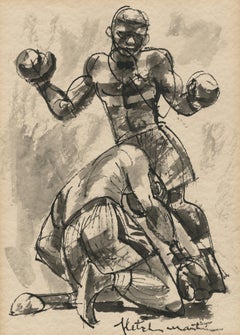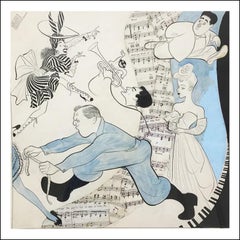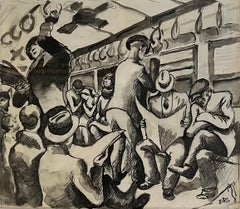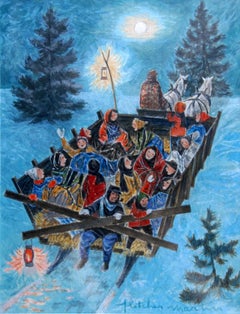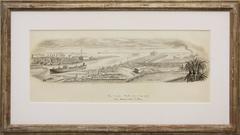Fletcher Martin Drawings and Watercolor Paintings
Fletcher Martin was an American painter, illustrator, muralist and educator. He is best known for his images of military life during World War II and his sometimes brutal images of boxing and other sports. Martin was born in 1904 in Palisade, Colorado, one of seven children of newspaperman Clinton Martin and his wife Josephine. The family relocated to Idaho and later Washington. By the age of 12, he was working as a printer. He dropped out of high school and held odd jobs such as lumberjack and professional boxer. He served in the U.S. Navy, 1922–26. Martin's artistic skills were largely self-taught.
1930s American Realist Fletcher Martin Drawings and Watercolor Paintings
Ink
1940s American Realist Fletcher Martin Drawings and Watercolor Paintings
Ink, Board
1930s American Realist Fletcher Martin Drawings and Watercolor Paintings
Paper, Ink, Gouache
1930s American Realist Fletcher Martin Drawings and Watercolor Paintings
Paper, Ink, Watercolor
Late 20th Century American Realist Fletcher Martin Drawings and Watercolor Paintings
India Ink
1930s American Realist Fletcher Martin Drawings and Watercolor Paintings
Paper, Ink
20th Century American Realist Fletcher Martin Drawings and Watercolor Paintings
Ink, Wax Crayon
1940s American Realist Fletcher Martin Drawings and Watercolor Paintings
Watercolor, Ink, Paper
1950s American Realist Fletcher Martin Drawings and Watercolor Paintings
Ink, Watercolor
1920s American Realist Fletcher Martin Drawings and Watercolor Paintings
India Ink, Pencil
1930s American Realist Fletcher Martin Drawings and Watercolor Paintings
Paper, Ink, Watercolor
Late 20th Century American Realist Fletcher Martin Drawings and Watercolor Paintings
India Ink
Late 20th Century American Realist Fletcher Martin Drawings and Watercolor Paintings
India Ink
1950s American Realist Fletcher Martin Drawings and Watercolor Paintings
Paper, Watercolor
1930s American Realist Fletcher Martin Drawings and Watercolor Paintings
Mixed Media
